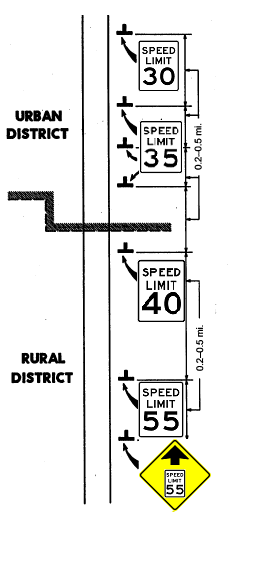Section 2: Regulatory Speed Zones
Anchor: #i1000700Introduction
A regulatory speed zone is the application, by Transportation Commission minute order, city ordinance, or county ordinance, of posted legal speed limits to sections of roadway where the numerical values of these special speed limits have been determined through engineering investigations of traffic and physical conditions.
Transportation Code, Chapter 545, Subchapter H, Section 545.362 established the method whereby the statewide maximum speed limit is altered by the national maximum speed limit laws. This function is administered by the Texas Department of Transportation (TxDOT) Traffic Operations Division (TRF) through the Texas Transportation Commission. However, Section 545.362 expired by its own terms upon repeal of the national maximum speed limit.
Anchor: #i1000715Within Incorporated Cities or Towns
The Texas Transportation Commission has the authority to alter the speed limits on highways within the corporate limits of cities or override a speed limit set by city ordinance on such highways.
TxDOT should make studies and present recommendations to the city for their acceptance and passage of a city ordinance to establish city speed zones.
Setting of speed limits within a city by Transportation Commission minute order should only be used as a last resort. TxDOT should make every effort to secure the cooperation of the city so that speed zones will be set by city ordinance.
Anchor: #i1000735Highway Approaches to Incorporated Municipalities
Speed zoning of highway approaches to municipalities should find its greatest application near the cities and towns where built-up business and residence areas require speeds below the statewide maximum for safe operation.
Graduated or buffer zones may be used on approaches to cities and towns to accomplish a gradual reduction of highway speeds to the speed posted at the city limits.
Anchor: #CHDDEICFMinimum Speed Limits
The need for minimum speed limits should be determined through an engineering and traffic investigation. When such a speed is justified, it should be regulated in the same manner as maximum speed limits are regulated.
Minimum speed limits are generally justified when studies show that slow moving vehicles on any part of a highway consistently impede the normal and reasonable movement of traffic to such an extent that they contribute to unnecessary lane changing or passing maneuvers.
The maximum speed limits and the need for minimum speed limits must be determined from the same speed check data. Chapter 3, Determining the 85th Percentile Speed, contains a discussion of the 85th percentile speed and minimum limits.
MINIMUM SPEED LIMIT signs (R2-4) shall be displayed in conjunction with and beneath the MAXIMUM SPEED LIMIT signs (R2-1) or as an integral sign (R2-4a).
Anchor: #i1000775Regulatory Speed Signs (R2 Series)
Signs for regulatory speed zones shall be from the R2 series as shown in the Texas Manual on Uniform Traffic Control Devices ( TMUTCD) and shall be of the appropriate design — including size, text, and color. At the end of speed zones on conventional highways where the maximum legal rural speeds are permissible, an R2-1 SPEED LIMIT XX sign (or larger size sign showing those limits) should be erected in accordance with the TMUTCD. At the end of speed zones on freeways where the maximum legal rural speeds are permissible, The R2-1 SPEED LIMIT XX sign showing those limits shall be erected.
Figure 2.2 illustrates the typical location and frequency of signs for regulatory speed zones. Distances shown between speed limit signs are examples and may be greater, depending on the results of speed checks. Posted regulatory speed limits will be based on the 85th percentile, as described in Chapter 3, Determining the 85th Percentile Speed.
Figure 2-2. Example regulatory speed zone application showing spacing of signs transitioning from rural district to urban district and within the urban district.
Anchor: #i1000805Signs Within Cities and Towns
TxDOT may erect and maintain speed limit signs on highway routes within the corporate limits of cities and towns where speed limits, based on the results of an engineering and traffic investigation, are established.
